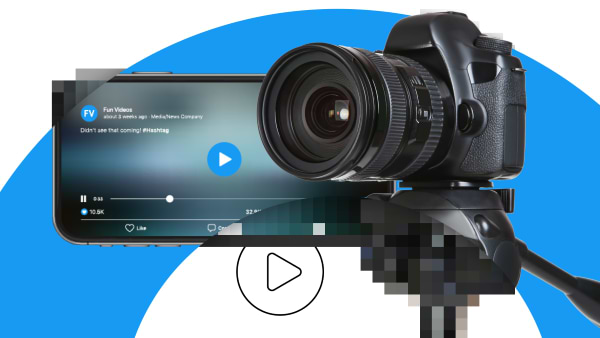HOW TO OPTIMIZE VIDEO FOR SEO
Learn to use your website's videos for a competitive edge in organic search traffic
THE BENEFITS OF BUILDING A VIDEO SEO STRATEGY
Just as video has become an essential part of paid marketing, your website is at a tremendous advantage if it includes high-quality video content. The question is, how do you optimize video SEO to improve your inbound organic traffic?
Before we get into that, allow us to express the importance of video content. While you probably already know what a powerful tool video content is for your online business, many wouldn’t immediately think to make video a part of a larger SEO strategy. Also, while video content is part of nearly every paid marketing campaign strategy, using video directly on your website is a huge advantage towards organic SEO traffic many brands ignore.
PEOPLE HAVE SHORT ATTENTION SPANS: IF YOU WANT TO ENGAGE CUSTOMERS YOU MUST USE VIDEO
A recent survey found that 87% of online marketers reported positive ROI from their paid marketing efforts. Curiously, other research has proven that online visitors retain 95% of the information watching video, versus just 10% of the text they read. Video SEO on your website has become crucial for your website’s SEO, regardless of the industry.
This is directly in line with the way media is absorbed online. Nearly a third of all time spent online is done watching videos. While eCommerce enterprises are less hesitant using video in their paid marketing efforts, many of the most popular eCommerce sites employ little to no video content in spite of the fact it organically outperforms static media.
VIDEO DRIVES SEO TRAFFIC
Just as video has become an essential part of paid marketing, your website is at a tremendous advantage if it includes high-quality video content. The question is, how do you optimize video SEO to improve your inbound organic traffic?
Before we get into that, allow us to express the importance of video content. While you probably already know what a powerful tool video content is for your online business, many wouldn’t immediately think to make video a part of a larger SEO strategy. Also, while video content is part of nearly every paid marketing campaign strategy, using video directly on your website is a huge advantage towards organic SEO traffic many brands ignore.
YOUTUBE, VIMEO, OR BUILD VIDEO IN THE SITE STRUCTURE?
After establishing the importance of video in your website’s content strategy, let’s establish the best way to use video SEO on your website. The first step is to decide how you want to add the video to your website, out of the three main ways of embedding:
-Youtube
-an alternate platform like Vimeo
-building a video directly into the structure of the site
Many small businesses will embed YouTube videos and try to leverage the online network’s enormous audience as well as Google’s likelihood of promoting videos in search, as they own Youtube. There is an inherent problem with this. As it’s a Youtube video it will include the entire Youtube platform, which will slow down your website, make your visitors watch ads and even lead them to your competitors’ videos. Worse yet, using the Youtube platform will slow down your Pagespeed.
If you look at the Google PageSpeed Index that measures a website’s performance Google will actually penalize you for embedding Youtube videos even though they own the company.
SHOULD YOU USE A VIDEO
HOSTING PLATFORM?
Another option is a hosting platform like Vimeo, which will give you some more versatility. It’s more customizable and will allow your videos to load without advertisements. Again, the last thing you want is a video to lead someone off of your page with advertisements or other suggested Youtube videos.
A good eCommerce website is one that has an intuitive user experience that keeps customers on the site browsing, to both establish trust and add more items to cart.
The best option is clearly to build the video into the structure of the website. If you embed videos from Youtube or Vimeo you cannot autoplay videos. If you want to make a silent autoplay video, directly embedding the video is an ideal option. It’s also much more professional. If you want to make a video to be shared across multiple platforms you always have the option to post on Youtube and whichever other social media platforms you decide to use.
The downside of hosting your own videos is that it requires a lot of bandwidth to host high-resolution video content. It will slow down your website substantially, and depending on your traffic, can greatly increase your server costs. Nevertheless, when you can optimize your media in a small file size, posting videos directly on your website is the best and most credible option and new technologies have emerged to present videos efficiently.
Given customer expectations, hosting videos is really the only option for any serious brand.
One of the clear ways to make a seismic shift in data usage is to limit the amount of data transferred. The average website’s weight consists of 90% media. Companies like Netflix have adopted smarter media formats to load faster and eliminate page weight without huge sacrifices in visual quality. However, a new technology has transformed the landscape of media optimization.
KEEP SELF-HOSTED VIDEO CONTENT BANDWIDTH SMALL WITHOUT COMPROMISING QUALITY
The main downside of video content is that it slows down your page load time. So if you’re optimizing your videos for SEO you don’t want that benefit counteracted by hurting your Google Core Web Vitals, which is a huge driver of organic SEO traffic.
SpeedSize media optimization can reduce the file size of your videos, visibly identical to the original content, as much as ~99% smaller in file size. This means your short videos will have a similar or smaller weight than the average image online. That means you won’t be penalized for high-res videos, your website will just look much better than your competitors and load much faster.
If you want to optimize your website’s videos, to drive more SEO traffic to your site, check out speedsize, the new standard in media optimization.





